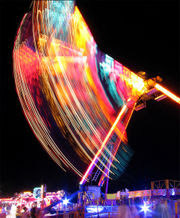Landscape art depicts scenery such as mountains, valleys, trees, rivers, and forests. Sky is almost always included in the view, and weather usually is an element of the composition. In the first century A.D., Roman frescoes of landscapes decorated rooms that have been preserved at Pompeii and Herculaneum. Traditionally, landscape art depicts the surface of the earth, but there are other sorts of landscapes, such as moonscapes, for example.
The word landscape is from the Dutch, landschap meaning a sheaf, a patch of cultivated ground. The word entered the English vocabulary of the connoisseur in the late 17th century.
Early in the fifteenth century, landscape painting was established as a genre in Europe, as a setting for human activity, often expressed in a religious subject, such as the themes of the Rest on the Flight into Egypt, the Journey of the Magi, or Saint Jerome in the Desert.
The Chinese tradition of "pure" landscape, in which the minute human figure simply gives scale and invites the viewer to participate in the experience, was well established by the time the oldest surviving ink paintings were executed.
In Europe, as John Ruskin realized, and Sir Kenneth Clark brought to view, landscape painting was the "chief artistic creation of the nineteenth century", with the result that in the following period people were "apt to assume that the appreciation of natural beauty and the painting of landscape is a normal and enduring part of our spiritual activity" In Clark's analysis, underlying European ways to convert the complexity of landscape to an idea were four fundamental approaches: by the acceptance of descriptive symbols, by curiosity about the facts of nature, by the creation of fantasy to allay deep-rooted fears of nature and by the belief in a Golden Age of harmony and order, which might be retrieved.
As explorers, naturalists, mariners, merchants and settlers arrived on the shores of Atlantic Canada in the early centuries of its exploration, they were confronted by what they saw as a hostile and dangerous environment and an unforgiving sea. These Europeans tried to cope with the daunting new land by mapping, recording and claiming it as their own. Their understanding of the specific nature of this land and its inhabitants varied greatly, with observations ranging from highly accurate and scientific to outlandish or fantastic. These observations are documented in the landscape artworks they produced. The best examples of Canadian landscape art can be found in the works of the Group of Seven.
 Motion blur is the apparent streaking of rapidly moving objects in a still image or a sequence of images such as a movie or animation.
Motion blur is the apparent streaking of rapidly moving objects in a still image or a sequence of images such as a movie or animation.